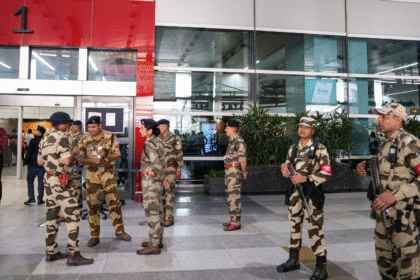Reinventing Airports — Adani’s ₹20,000 Crore Pivot to City‑Side Infrastructure
Adani Airports has embarked on a bold strategic shift—announcing a comprehensive ₹20,000 crore investment in city‑side infrastructure across its airport network. Impressively, nearly 70% of this capital is earmarked for Mumbai and Navi Mumbai airports, aiming to redefine what airports can offer to travelers and local communities alike
This move is not just about enhancing operational capacity—it’s about transforming airports into thriving “airport cities”. Inspired by global models like Amsterdam’s Schiphol and Zurich’s Circle, Adani envisions airport spaces as vibrant urban districts featuring retail malls, office towers, hotels, and hospitality-driven developments
Currently, aeronautical operations contribute around 50% of Adani Airports’ revenue—on par with the industry average. This city‑side push is crafted to change that balance significantly. By 2030, the goal is to reduce dependence on aeronautical revenue to under 30%, with non‑aeronautical streams—like retail, F&B, hospitality, and commercial leases—contributing up to 70% It’s a bold bet on resilience through diversification.
Why Mumbai and Navi Mumbai Take the Lead
Navi Mumbai International Airport (NMIA) stands at the heart of this transformation—a 240-acre mixed-use zone slated to open by October 2025. The first phase alone covers 50 acres and includes five hotels (totaling around 1,000 keys), a large shopping mall, three office towers, and limited-service apartments . The full phase is expected to wrap up by 2031
This kind of development is as much about destination appeal as it is about functionality. A bustling “walkable business district,” NMIA will serve travelers, businesses, and locals—blurring the lines between airports and urban life
Building Momentum Across the Portfolio
Phase 1 is already underway across eight airports, spanning 114 acres. Besides the core developments in Mumbai‑Navi Mumbai, the remainder is spread across Ahmedabad, Lucknow, Jaipur, Guwahati, Bengaluru, and Thiruvananthapuram
This expansion is built on solid growth: In Q1 FY26, Adani Airport Holdings Ltd posted revenue of ₹2,715 crore, a healthy 25% year-on-year rise, fueled by higher passenger traffic and increasing non‑aeronautical revenues
Simultaneously, the group raised $750 million through external commercial borrowings to refinance debt and fuel expansions in retail, duty-free, and F&B offerings across its airport network
A Bold Strategy for Sustainable Growth
Adani Airports’ ₹20,000 crore city‑side plan is more than investment—it’s a vision for the future of aviation infrastructure. It reshapes airports from transient transit points into self‑sustaining economic ecosystems that serve travelers and urbanites 24/7. The pivot positions Adani to ride new revenue waves, reduce volatility, and anchor its expanding airport portfolio in high-margin, customer‑centric real estate.
The Mumbai & Navi Mumbai Focus – Strategic Urban Integration
As Adani Airports commits ₹20,000 crore toward cityside infrastructure, the decision to allocate 70% of this massive investment to Mumbai and Navi Mumbai is both tactical and symbolic. These twin urban giants, often described as the financial lungs of India, represent an evolving aviation frontier where airports are no longer mere transit points—they are becoming urban hubs of commerce, logistics, and connectivity.
Why Mumbai Matters
Mumbai’s Chhatrapati Shivaji Maharaj International Airport (CSMIA), already under Adani Airports’ management, is one of India’s busiest and most lucrative airports. However, its cityside development has long remained constrained by urban congestion, regulatory delays, and complex land dynamics. With this ₹20,000 crore investment, approximately ₹14,000 crore will be channeled toward reshaping the surrounding infrastructure.
The goal is to create a seamless integration between airside efficiency and cityside experience—an ecosystem that can accommodate high-end retail, office complexes, hotels, logistics centers, and transport interchanges. The result will be a mega-airport district that functions as an economic node, capable of generating employment, enhancing tourism, and stimulating commerce.
Navi Mumbai – The New Aviation Capital?
Meanwhile, Navi Mumbai International Airport (NMIA)—India’s most ambitious greenfield airport project—presents a blank canvas for futuristic urban planning. Expected to be operational by 2025, NMIA offers a chance to avoid the mistakes of older airports, by embedding cityside design into its masterplan from the start.
Adani’s commitment to dedicating a significant chunk of the investment here suggests they envision a smart city-airport synergy. The NMIA cityside could feature urban forests, data centers, digital command hubs, and sustainable transport options like EV corridors and sky shuttles. The long-term vision is to transform this airport zone into a live-work-play-learn environment, akin to airport cities seen in Dubai, Incheon, or Amsterdam.
The 70% Rationale: A Bet on Density and Demand
Allocating 70% of total capital to Mumbai and Navi Mumbai isn’t arbitrary. These cities are gateways to India’s western economic corridor. Together, they handle nearly 30% of India’s air cargo and passenger traffic. As urban sprawl extends into Navi Mumbai and Thane, the demand for integrated airport zones will surge. Real estate around these hubs is already booming, and Adani’s investment is poised to catalyze this trend further.
Policy Alignment and Government Push
The Maharashtra state government, along with the Civil Aviation Ministry, has recently fast-tracked multiple approvals to ensure timely execution of airport-linked development. There is also talk of introducing special economic zones (SEZs) or urban enterprise zones within the airport peripheries to encourage tech firms, start-ups, and global logistics players to set up operations.
These efforts align well with India’s National Infrastructure Pipeline (NIP) and Gati Shakti masterplan, under which cityside airport development is a priority vertical. Adani’s plans serve as a private-sector parallel to public policy, forming a model of public-private synergy.
Challenges: Regulatory, Environmental, and Social
Despite the optimism, the challenges cannot be understated. Land acquisition in Navi Mumbai has historically led to protests by local villagers and environmental activists. Mangrove destruction, coastal regulatory zone (CRZ) violations, and concerns over noise pollution remain key sticking points.
For Adani Airports, success will depend on transparent engagement with stakeholders, compliance with green norms, and delivering tangible benefits to local communities—such as jobs, relocation benefits, and upgraded civic infrastructure.
In dedicating over 70% of its ₹20,000 crore cityside infrastructure investment to Mumbai and Navi Mumbai, Adani Airports is signalling more than just a financial commitment—it’s a vision of turning airport infrastructure into economic super-engines. But this vision must coexist with ecological sustainability, public trust, and urban coherence.
India’s Airport Privatization Drive – The Bigger Picture
As Adani Airports Group deepens its commitment with a ₹20,000 crore infusion into cityside infrastructure, it does so amid a larger, strategic shift in India’s aviation landscape: the aggressive privatization and corporatization of airports. What started as a public-private partnership (PPP) experiment is now a full-fledged transition toward privately managed and commercially driven airport ecosystems.
A Paradigm Shift in Airport Management
Historically, India’s airports were operated by the Airports Authority of India (AAI), a government agency burdened with bureaucratic inertia. But by 2019, the Modi government began auctioning off airport operations under a revenue-sharing model. The result? Adani Group emerged as the largest private airport operator, managing seven key airports: Ahmedabad, Lucknow, Jaipur, Guwahati, Thiruvananthapuram, Mangaluru, and Mumbai. Navi Mumbai was added soon after.
This shift is no longer just about operational control—it’s about redefining airports as urban economic engines. The cityside infrastructure strategy is not merely an extension of runway logistics but a reimagination of what an airport can be in the 21st century.
Privatization as a Growth Catalyst
Privatization has had a measurable impact on airport modernization and passenger experience. Under Adani’s management, airports like Lucknow and Jaipur have seen fast-tracked development of terminals, digitization of services, and improved hygiene and logistics.
But more importantly, these airports are now pivoting to unlock the commercial potential of underutilized land. The cityside vision includes:
- Shopping arcades and malls
- Premium hotels and convention centers
- Cargo parks and bonded warehouses
- EV charging zones and multimodal transit integration
This builds a high-revenue, high-efficiency model where non-aeronautical revenue (like retail and leasing) becomes as vital as airline operations.
Lessons from Global Airport Cities
Adani’s cityside push is deeply influenced by successful models abroad. Consider:
- Amsterdam Schiphol: Integrates offices, hotels, and residential zones in a coherent aerotropolis design.
- Incheon (Seoul): Known for its “airport city” complete with casinos, tech hubs, and free-trade zones.
- Changi (Singapore): Emphasizes entertainment and retail alongside aviation logistics.
Adani Group has made no secret of its ambition to replicate these models in India, combining high-end urban planning with the power of private investment. The ₹20,000 crore infusion is expected to unlock similar layers of economic density around Indian airport terminals.
Economic Ripple Effects
Let’s break down how this investment will ripple through various sectors:
- Real Estate: Prices around Mumbai and Navi Mumbai airports have already surged in anticipation of large-scale development. Analysts project a 30–50% appreciation over five years.
- Employment: Cityside development zones could generate over 1 lakh direct and indirect jobs in retail, logistics, hospitality, construction, and tech.
- Tourism and Conferences: With more hotel infrastructure and MICE (Meetings, Incentives, Conferences, and Exhibitions) spaces, cities like Mumbai can attract more business tourism.
- Air Cargo and E-commerce: Warehousing facilities near airports speed up last-mile delivery, critical for sectors like pharmaceuticals, perishables, and online retail.
Public-Private Synergy and Concerns
The success of privatization-driven cityside infrastructure depends on robust collaboration with public authorities. Zoning laws, transit permits, and environmental approvals remain critical hurdles. Additionally, watchdogs have raised concerns about:
- Monopolistic behavior by conglomerates
- Passenger fee hikes
- Displacement of small vendors or traditional airport businesses
Transparency, oversight, and public engagement are crucial to ensure that privatization doesn’t come at the cost of public interest.
India’s airport privatization push is no longer in a pilot phase. With Adani Group leading the charge, the future of Indian aviation lies in private investment-led development—especially cityside ecosystems that bring in exponential growth. However, this journey must be carefully balanced with equity, accessibility, and ecological responsibility.
Integrating Airports with Urban Mobility and Sustainable Planning
As Adani Group’s ₹20,000 crore investment gains momentum, it becomes evident that this is not just about transforming airports—it’s about transforming cities. The cityside infrastructure model is not an isolated aviation development. It is fundamentally linked to India’s evolving urban mobility strategies, sustainable infrastructure goals, and the shift towards smarter, greener cities.
Airports as Multi-Modal Transit Hubs
Modern airports are no longer end-destinations—they’re seamless transit gateways. In Mumbai and Navi Mumbai, Adani Group’s vision is to integrate airport premises with a matrix of urban mobility systems:
- Metro Connectivity: The Mumbai Metro Line 8 (Dahisar to Airport) and Navi Mumbai Metro are critical links that will feed into the airport ecosystem.
- Bus Rapid Transit (BRTS): High-frequency buses connecting cityside zones to suburban regions are being planned for both cargo and passenger needs.
- Suburban Rail Upgrades: In Mumbai, the integration of airport cityside areas with Western and Central Railway stations through skywalks and shuttles is under consideration.
This holistic connectivity not only reduces travel time but makes the airport a nucleus of urban movement rather than an endpoint.
The “15-Minute City” Meets the “Aerotropolis”
Urban planners are now blending the concept of the “15-minute city”—where work, leisure, and daily needs are all within 15 minutes of home—with the “aerotropolis” model that sees the airport as the central economic district.
Adani Airports’ cityside zones are being designed to serve:
- Office Parks: Plug-and-play commercial spaces for tech startups, logistics firms, and global companies.
- Retail Hubs: Multiplexes, malls, and luxury shopping avenues tailored for both local residents and international flyers.
- Healthcare Clusters: High-end hospitals and wellness centers within the vicinity, targeting medical tourists and local urban populations.
- Education and Training Institutes: Aviation academies, logistics training centers, and hospitality schools embedded in the airport ecosystem.
By integrating these, airports become self-sustaining economic microcosms—fueling growth beyond aviation.
Green Infrastructure and ESG Goals
A critical pillar of the ₹20,000 crore investment is Environmental, Social, and Governance (ESG) compliance. Adani Group has publicly committed to making all its airports carbon neutral by 2030.
Here’s how the cityside plans are aligned with sustainable development goals:
- Solar Power Integration: Rooftop and cityside solar farms to power terminal operations and auxiliary infrastructure.
- Rainwater Harvesting & STPs: Advanced water recycling units for all landscape and sanitation needs.
- Electric Mobility: EV-only cityside zones, with charging stations for cars, buses, and even cargo vehicles.
- Pedestrian Zones & Cycling Paths: Encouraging low-emission commuting within the airport city for employees and passengers alike.
These efforts go beyond optics—they directly tie into India’s COP26 climate pledges and the national carbon neutrality roadmap.
Navigating Policy, Regulation, and Bureaucracy
Ambitious infrastructure projects in India face inevitable friction points with bureaucracy, legal hurdles, and inter-departmental conflicts. Adani’s cityside model—especially in densely populated zones like Mumbai—requires the synchronisation of:
- Urban Development Departments
- Municipal Corporations (BMC, NMMC)
- Civil Aviation Authorities
- Environmental Regulators (MoEF, MPCB)
For example, the Navi Mumbai International Airport (NMIA) project had to navigate nearly two decades of land acquisition disputes, environmental assessments for mangrove loss, and compensatory resettlement plans for displaced villages.
Today, those lessons are being applied to make the cityside rollout smoother, especially when it comes to obtaining fast-track clearances, public consultations, and transit-oriented zoning.
The Socio-Economic Opportunity and Challenge
While the cityside strategy unlocks significant economic potential, it also raises important socio-political questions:
- Will local communities benefit directly from these developments, or will they be displaced?
- How inclusive will the employment model be?
- Can affordable housing and access to amenities be preserved in high-growth zones?
Adani Airports’ long-term success depends on its ability to answer these questions proactively. Employment guarantees, skilling programs, and community engagement initiatives need to move in lockstep with infrastructure development.
The transformation of airports into smart city extensions is no longer a distant dream—it’s unfolding right now in Mumbai and Navi Mumbai. Adani Group’s ₹20,000 crore investment represents a turning point in how India builds infrastructure: interconnected, sustainable, and deeply tied to its urban future.
But the complexity of executing such a vision in a city like Mumbai—one of the world’s most densely populated metropolises—demands patience, precision, and public trust.
Reshaping India’s Economic Corridors Through Airport-Driven Development
Adani Group’s bold ₹20,000 crore investment into cityside infrastructure is not just catalyzing a new phase in aviation—it’s redrawing India’s economic map. As the cityside expansions at Mumbai and Navi Mumbai airports gather steam, their ripple effects are being felt far beyond the terminal gates. These projects are creating high-efficiency economic corridors, logistical chains, and urban clusters that are redefining how India connects domestically and globally.
Airports as Gateways to Global Trade Corridors
Mumbai’s Chhatrapati Shivaji Maharaj International Airport (CSMIA) is among India’s top cargo gateways. With Adani’s investment now extending into cargo terminals and adjacent warehousing infrastructure, the airport is being converted into a next-gen logistics hub.
Key developments include:
- Dedicated Cargo City: Integrated with air freight stations, bonded warehouses, cold chain storage, and perishable goods handling.
- Connectivity to JNPT: Enhanced rail and road links to Jawaharlal Nehru Port Trust (JNPT), enabling seamless air-sea cargo transfers.
- Customs & Clearance Digitisation: Smart e-clearance systems to reduce processing times and eliminate bottlenecks.
This integration ensures India doesn’t just move people faster—but moves goods faster, cheaper, and more efficiently—an essential driver for MSMEs, e-commerce, and manufacturing exporters.
Cityside Development and Economic Clustering
The theory of “economic clustering” posits that businesses thrive when they co-locate near essential infrastructure. With Mumbai and Navi Mumbai airports at the heart of this transformation, new aero-commercial clusters are being developed with precision:
- BKC 2.0 near NMIA: Navi Mumbai International Airport’s surrounding development zone is planned as a second Bandra-Kurla Complex, with global MNCs, fintech parks, and convention centers.
- Tech Corridors: IT campuses and data centers are being proposed near cityside zones, supported by uninterrupted power, data fiber grids, and fast transit.
- Logistics & Warehousing Belts: With proximity to highways, ports, and the airport, logistic companies are relocating near the cityside infrastructure.
These zones generate massive employment, stimulate real estate appreciation, and attract FDI—giving India a chance to replicate the success of global airport cities like Incheon (Seoul) or Schiphol (Amsterdam).
Real Estate and Commercial Investment Boom
Cityside development isn’t confined to aviation or logistics—it’s a goldmine for India’s commercial real estate sector. Large institutional investors, global REITs, and domestic players are now eyeing airport-adjacent zones for:
- Grade-A commercial office buildings
- Premium hotels and hospitality chains
- High-street retail
- Co-living and co-working spaces
For instance:
- Mumbai International Airport Ltd (MIAL) is in talks with hospitality giants like Hyatt and Marriott for cityside hotel development.
- NMIA’s cityside blueprint includes a mixed-use real estate development zone spanning over 600 acres.
As aviation footfall grows, these properties gain not only higher lease value but also sustained demand from business travelers, tourists, and aviation staff alike.
Boost to Regional Economies and MSMEs
The regional impact of cityside infrastructure is profound. Navi Mumbai, Panvel, and Raigad districts are witnessing:
- Rise in ancillary businesses such as courier services, food vendors, taxi operators, and warehousing support
- Employment surge in construction, security, maintenance, and facility management roles
- Uptick in MSMEs leveraging airport-linked logistics to export goods
The strategy is two-fold:
- Urban upliftment through infrastructure-led employment
- Micro-level economic decentralisation—enabling small towns and peri-urban areas to plug into global trade networks
The net result is a more balanced growth model—one that bridges India’s economic disparities between mega cities and rising satellite towns.
Global Benchmarks and Competitive Advantage
Adani Airports’ cityside blueprint is heavily benchmarked against international case studies:
- Singapore Changi Jewel – for mixed-use leisure and commercial spaces
- Dubai Airport Freezone (DAFZA) – for logistics, commerce, and trade operations
- Heathrow’s Airport City (London) – for real estate-led economic activity
But the difference lies in cost structure. India offers:
- Cheaper land acquisition (especially in Navi Mumbai)
- Skilled yet affordable labour
- Strategic time-zone and oceanic access to Southeast Asia, Middle East, and Africa
This positions India—via Adani Airports—as a logistical and aviation hub of the Global South.
Cityside airport infrastructure is becoming the new frontier of economic warfare—a space where nations compete not just through air travel capacity, but through the productivity, connectivity, and innovation ecosystems that surround their runways.
Adani’s ₹20,000 crore investment is not a standalone project—it is India’s declaration of intent to be a global aviation and logistics power. But the journey is far from over. As we move ahead, the focus must shift towards governance, transparency, and ensuring that prosperity doesn’t become gated but remains accessible to all.







